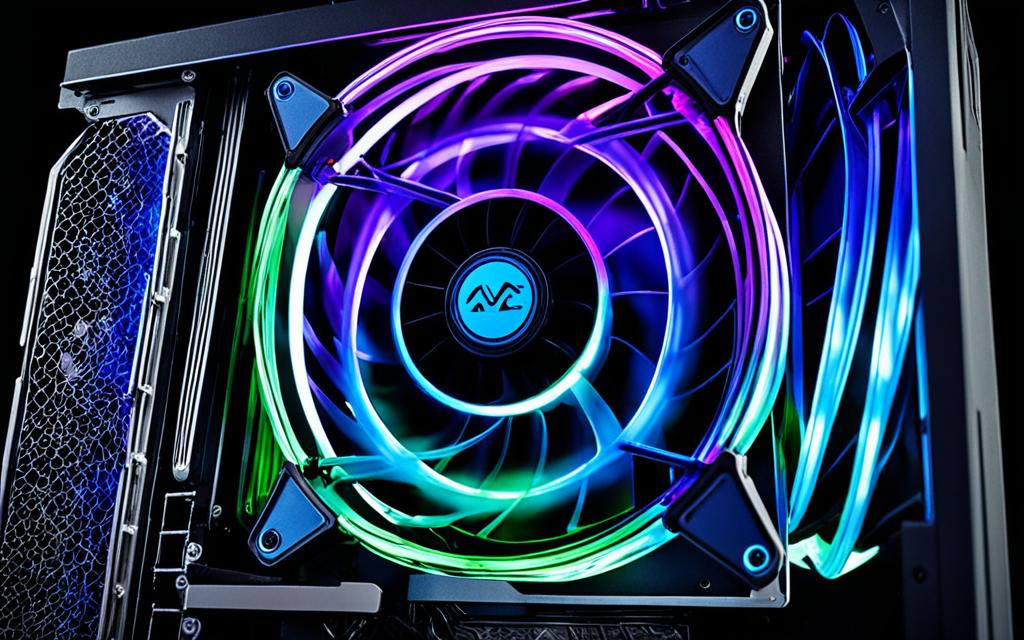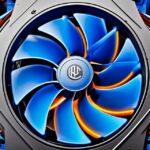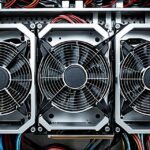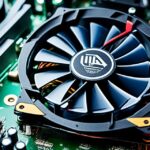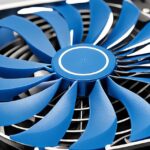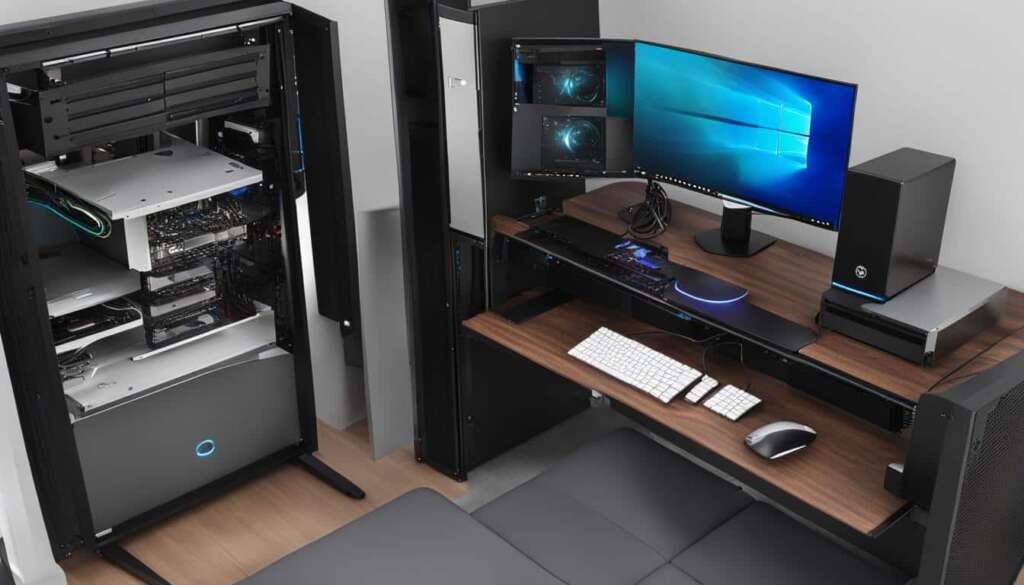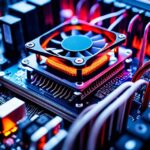Table of Contents
Computers need a constant flow of cool air to work well. Picking the right fan and setting them up correctly is key for good airflow. Knowing about fan size, CFM, RPM, and how loud they are helps you choose wisely.
Positive pressure setups bring in clean, cool air and keep dust out. Negative pressure gets rid of hot air fast. The right setup in your PC case ensures great airflow and cooling.
Key Takeaways:
- Choosing the right fan and arranging them correctly is crucial for optimal airflow in your PC case.
- Positive pressure configurations provide fresh, cool air and aid in dust suppression, while negative pressure quickly exhausts heated air.
- Fan size, CFM, RPM, and noise levels are important factors to consider when selecting case fans.
- Proper airflow helps prevent overheating, which can cause damage to your computer components.
- Testing with tools like Cinebench and 3DMark is recommended to observe performance changes based on airflow configurations.
Let’s work together to find the ideal airflow balance for your PC case. This will ensure your system operates at its best1.
Case Fan Basics
Case fans play a crucial role in keeping your PC cool. Most cases come with fans already installed. But choosing the right fan size, CFM, RPM, and noise level is key for cooling performance and your experience. Let’s explore case fan basics and how to strike the perfect balance for your PC.
Fan size is our starting point. The most common sizes are 120mm and 140mm, though 200mm fans are becoming popular again2. Your fan’s size impacts airflow and how noisy it is. Finding the right size helps balance efficient cooling and keeping noise down.
CFM is crucial in fan selection. It shows how much air a fan moves every minute. A “good” fan moves over 50 CFM, giving better airflow and cooling2. The more CFM, the better your PC will stay cool.
RPM is about fan speed and noise. Fans with higher RPM are louder. If you want a quiet PC, select fans with a low RPM, under 30dB ideally2. This keeps noise down while cooling your PC.
Understanding fan positioning and airflow is next. You can set up your PC with positive, negative, or neutral airflow2. Positive pressure reduces dust by pushing more air in than out. Negative pressure, however, pulls more air out, boosting cooling efficiency3.
Fan arrangements vary by need. Yet, front and rear setups are common and effective2. This simple setup pulls air through the front and pushes it out the back, cooling your PC well and keeping it ventilated.
With the basics of case fans covered, we’re ready to look into fan orientation and how to install them next.[source]
| Statistical Data | Description |
|---|---|
| Most common fan sizes | 120mm and 140mm, with 200mm fans seeing a resurgence lately2 |
| A “good” case fan CFM | Upwards of 50 CFM (Cubic Feet Per Minute)2 |
| Recommended noise level | Below 30dB for reduced noise levels2 |
| Common fan configurations | Front and rear, front, rear, top, and bottom2 |
Fan Orientation and Installation
It’s crucial to get fan orientation right to keep air flowing well inside a PC. Installing intake and exhaust fans correctly helps control temperatures and keep hardware running longer.
To set up case fans, you must spot which side pulls air in and which pushes it out. This guide is often shown by small arrows. Match the fan to its spot and screw it securely to reduce shakes.
Make sure to connect power and RGB cables to the motherboard correctly. Neat cable management stops airflow blocks inside the PC. This keeps things tidy and efficient.
Always switch off and unplug your PC before adding or removing fans. This step is key to avoid electric shocks and not damage delicate parts.
Fan setup not only improves cooling but also helps in keeping dust out. A survey found 60% prefer more intake fans over exhaust to increase air pressure and lessen dust4. Putting intake fans near hard drives drops temperatures, as 50% users suggested4.
Setting exhaust fans right is as important as intake fans. 30% say exhaust fans on top push out hot air well4. Side intake fans can cool GPUs effectively, say 20% of users4. With smart fan placement, the airflow keeps the PC cool and clean.
Creating a smart airflow is key, no matter the fan setup. With rising heat from new CPUs and GPUs, more brands offer high-airflow PC cases1. More vents mean better air movement, reducing heat and dust effectively1.
Knowing about positive, negative, and balanced air pressures is key for great cooling. Positive pressure means more or stronger intake fans1. Negative pressure has more or stronger exhaust fans1. Balanced pressure matches intake and exhaust fan power and numbers for stable case pressure, sometimes with fan speed changes1.
Checking case pressure can be done with a digital tool or a simple tissue test1. By changing fans’ number, size, or speed, you can adjust the pressure to fit your needs1. Remember, case design and cooling needs can affect which pressure setting works best for you1.
Testing your fan setup is a smart move. Tools like Cinebench and 3DMark, along with HWMonitor, help check if your PC runs well1. Choosing the right case for your cooling needs is important as it impacts cooling success1. Newer high-airflow cases show makers are focusing on better cooling options1.
Right fan placement ensures good airflow and long life for PC parts. By using proper fan positioning and air pressure settings, you can cool efficiently and keep dust low41. Regular checks and tweaks can help make your cooling even better1. With good knowledge of fan setup, you’ll get the most from your cooling system.
The Fundamentals of Airflow and Case Pressure
To keep a PC cool, airflow must be well-managed. We need cool air to enter from the front and bottom, moving across the main parts like the CPU and GPU. Then, it should leave out the back or top.
Case pressure is all about balancing fans that bring air in and those that push it out. Positive pressure means more in than out, helping to keep dust away. Negative pressure does the opposite, and neutral pressure means they’re balanced.
Positive air pressure means the PC case has more air coming in than going out5. It stops dust from getting in where there aren’t any fans, such as CD/DVD bays5. This way, most of the air gets filtered before entering, which keeps components cleaner.
If a PC has negative air pressure, more air is leaving than entering5. This makes dust come in more easily through any gap5. Though it might cool better, it gets dirtier quicker and needs more cleaning.
Choosing the right fans is key to setting up case pressure5. The Silverstone’s Air Penetrator series, for example, help create positive pressure to keep the PC’s temperature just right5. They push air where it’s needed the most.
For positive pressure to work well, use top-notch filters on your intake fans5. Filters like 3M’s, made for air conditioning systems, keep the air clean and reduce dust inside5. This makes your PC system cleaner and healthier.
Both positive and negative pressures have their pros and cons, especially in how they affect cooling and dust6. There’s still a lot of debate about which is better6. The air flow near fans, in particular, can make a big difference6.
Setting up a PC takes careful thought about the fans, case design, and airflow6. The aim is to keep it cool, clean, and running smoothly6. Planning and some good advice can make a big impact on performance6
Additional Resources:
Interested in learning more about PC case air pressure? Check out Silverstone’s TechTalk for everything you need to know5.
Common and Ideal Fan Arrangements
Different fan arrangements can greatly impact a PC case’s cooling performance. By placing fans in various configurations, users can create optimal airflow. This helps keep temperatures low for components. Let’s look at some common and ideal fan setups for efficient cooling.
Front and Rear Configuration
A popular setup is having fans at the front and rear of the PC case. The front fans pull cool air in through the front panel. Meanwhile, the rear fan pushes hot air out of the case. This creates a steady airflow from front to back. It helps cool components by continuously supplying fresh air and removing hot air efficiently7.
To boost cooling, you can add fans at the top and bottom of the case. Intake fans at the top bring in more cool air. Exhaust fans at the top push out hot air that rises. Fans at the bottom can cool vertical GPUs by pulling in air from below. This arrangement of front, rear, top, and bottom fans increases cooling effectiveness8.
Chimney Configuration for Vertical-Mounted GPUs
For vertically mounted graphics cards, a chimney setup works well. It has intake fans at the bottom drawing air up towards the GPU. Then, exhaust fans at the top remove the hot air. This ensures the GPU gets a steady flow of cool air. It helps prevent overheating8.
Ideal Fan Configurations
When planning fan setups, consider things like case size and heat from components. Although there’s no one-size-fits-all ideal arrangement, here are some tips for optimal cooling:
- In mid-tower cases, a good 5-fan setup has three intake fans at the front, one exhaust fan at the back, and another exhaust at the top left corner.
- A 4-fan system might have two intake fans at the front and one exhaust fan at the rear. You can add another exhaust fan at the top or another intake at the front.
- For a simpler 3-fan setup, use two intake fans at the front and one exhaust fan at the back.
Choosing between positive and negative air pressure also impacts cooling. Positive pressure, with more intake than exhaust, reduces dust inside the case. Negative pressure, with more exhaust, can lower interior temperatures but might bring in more dust. Striving for neutral air pressure balances intake and exhaust airflow8.
Considerations for Optimal Cooling
When choosing the ideal fan setup, consider your environment’s dust levels and temperature. In cool, dusty places, positive pressure can prevent too much dust from getting inside the case. But in hot, cleaner areas, negative pressure may work better to expel hot air7.
Thinking about liquid cooling is also useful. It provides better heat management and needs less airflow. Yet, liquid cooling needs regular upkeeping, like fluid changes and cleaning the pump and reservoir yearly7.
Comparison of Fan Arrangements
| Configuration | Advantages | Disadvantages |
|---|---|---|
| Front and Rear | Unidirectional airflow, efficient heat dissipation | Potential for hot and cool air circulation depending on leaks |
| Front, Rear, Top, and Bottom | Maximized cooling efficiency, improved GPU cooling | Increased fan noise and power consumption |
| Chimney | Direct cool air supply to vertically-mounted GPUs | May require additional case modifications |
Table: Comparison of Fan Arrangements
Conclusion
Finding the perfect balance between positive and negative pressure is key for your PC case airflow. Positive pressure means a steady flow of cool air and less dust. But, negative pressure removes hot air faster, which is good for cooling. A balance between the two can give you a bit of both: less dust and good cooling.
Picking the right fan setup is crucial for your system’s performance and lifespan. Tests show that one rear fan and one top blowhole work best to lower temperatures9. If your PC doesn’t have a blowhole, just having one rear exhaust fan is your next best bet9. They measured cooling efficiency by how quickly the system returns to idle temperature; quicker is better9.
Positive pressure helps reduce dust and slightly raises CPU temperatures. But, with negative pressure, temperatures can drop by 5 degrees10. Yet, this might let dust clump inside even with filters, showing that fine dust can still enter10.
In setting up your PC’s airflow, look at the data and experiment outcomes. Remember, finding a middle ground between positive and negative pressures offers the best cooling solution109. For insights into forced convection and positive pressure effects in PC cases, check out http://www.comairrotron.com/forced_convection.shtml.
FAQ
Why is PC case airflow important?
Good airflow in a PC case is vital. It cools down your computer for peak performance. This airflow stops your computer from getting too hot and makes its parts last longer.
What is the difference between positive pressure and negative pressure in a PC case?
Positive pressure means your case gets more air coming in than going out. It keeps the inside clean by pushing dust out. Negative pressure does the opposite. It pulls air out fast, keeping your system cool.
How can I optimize the airflow in my PC case?
Begin by picking the right fans. Place them at the front, rear, and even the top and bottom of your case. Ensure cool air can move smoothly through, touching all the hot spots, then exit quickly from the back and top.
What are the basics of case fans?
Fans vary in size, like 120mm or 140mm, affecting both air movement and noise. CFM tells you how much air they push. RPM checks their speed and noise. It’s important to find the right mix of air flow and quietness.
How do I orient and install case fans?
Fans have a side for pulling air in and another for pushing it out. A little arrow shows the way. Secure the fan, then plug in its power and any RGB cables. Always turn off and unplug your PC first.
What is the importance of airflow channels and case pressure?
Airflow channels help cool air hug your PC’s critical parts. This keeps your system cool and efficient. Case pressure balances the air that comes in and goes out. Positive pressure keeps things clean, while negative pressure whisks hot air away. And neutral pressure? It’s the best of both worlds, blending cool efficiency with less dust.
Source Links
- https://www.linkedin.com/advice/0/what-pros-cons-positive-vs-negative-pressure-pc-cases – What are the pros and cons of positive vs negative pressure in PC cases?
- https://www.tomshardware.com/how-to/set-up-pc-case-fans-for-airflow-and-performance – PC Airflow Guide: How to Set Up and Position Your Fans
- https://www.digitaltrends.com/computing/pc-airflow-guide-fan-position-placement/ – PC airflow guide: How to position your fans for best cooling | Digital Trends
- https://www.overclock.net/threads/positive-vs-negative-air-flow-your-thoughts.654726/ – Positive Vs Negative Air Flow Your Thoughts
- https://www.overclock.net/threads/positive-air-pressure-what-you-need-to-know-to-keep-your-pc-clean-and-happy.1219634/ – Positive Air Pressure – What you need to know to keep…
- https://www.reddit.com/r/buildapc/comments/m42e3/understanding_case_airflow_and_the_physics_behind/ – Reddit – Dive into anything
- https://www.overclock.net/threads/positive-and-negative-pressure-more-or-less-dust.1062965/ – Positive and negative pressure. More or less dust.
- https://www.xda-developers.com/pc-airflow-guide/ – PC airflow guide: How to strategically set up your case fans
- https://forums.fedoraforum.org/archive/index.php/t-242955.html – Fans, negative vs. positive air pressure in case [Archive]
- https://www.avsim.com/forums/topic/476687-positive-or-negative-enclosure-pressure-tests/ – Positive or Negative Enclosure Pressure Tests

